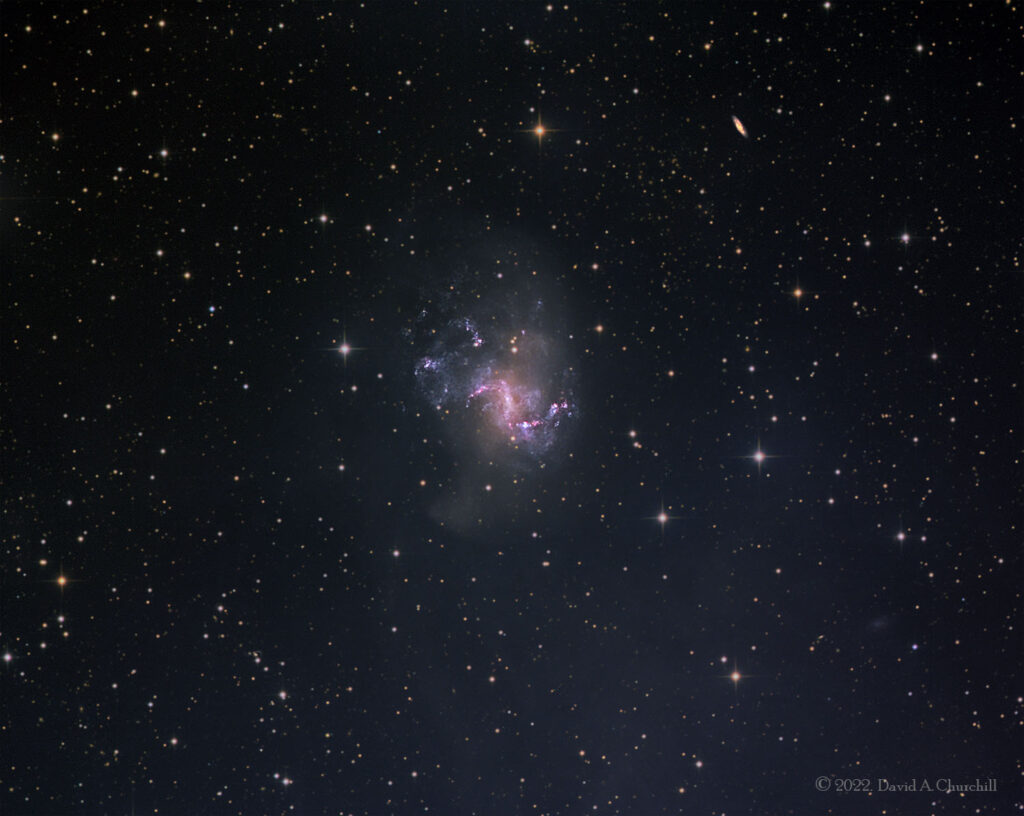NGC 1313
Barred-Spiral Galaxy, Reticulum
- Description
- Technical
- Links
Young, blue stars are scattered across the galaxy. This is evidence of infant mortality in which the young open clusters quickly became gravitationally “unglued”, scattering their resident stars into the galaxy. The galaxy bears some resemblance to the Magellanic Clouds and hosts two ultraluminous X-ray sources, called NGC 1313 X-1 and X-2. The former is a rare intermediate-mass black hole.
In 2007, a rare WO star was discovered in NGC 1313, currently known by its only designation of [HC2007] 31. It is of spectral type WO3. The derived absolute magnitude is about -5, which is very high for a single WO star. (WOs usually have absolute magnitudes of about -1 to -4) This means that the WO is likely part of a binary or a small stellar association.
NGC 1313 has a strikingly uneven shape and its axis of rotation is not exactly in its centre. NGC 1313 also shows strong starburst activity and associated supershells. NGC 1313 is dominated by scattered patches of intense star formation, which gives the galaxy a rather ragged appearance. The uneven shape, the ragged appearance and the strong starburst can all be explained by a galactic collision in the past. However, NGC 1313 seems to be an isolated galaxy and has no direct neighbours. Therefore, it is not clear whether it has swallowed a small companion in its past.
Telescope: Planewave CDK17 (FR) f4.5
Mount: Astro Physics 1600GTO
Camera: QHY16200A/ Integral FW
Guider: Agena Starguide II / ZWO ASI178MM
Filters: Astronomik 36mm LRGB
L: 52×10 mins = 520 mins, R: 24×10 mins = 240 mins, G: 24×10 mins = 240 mins, B: 24×10 mins = 240 mins
Total Imaging Time: 20h 40m
Data Imaged remotely over 4 nights during October 2022.
Imaged from Observatorio El Sauce, Chile, in partnership with Fred Espenak.
Data acquisition & Processing by David Churchill.
Telescope: Planewave CDK17 (FR) f4.5
Mount: Astro Physics 1600GTO
Camera: QHY16200A/ Integral FW
Guider: Agena Starguide II / ZWO ASI178MM
Filters: Astronomik 36mm LRGB
L: 52×10 mins = 520 mins, R: 24×10 mins = 240 mins, G: 24×10 mins = 240 mins, B: 24×10 mins = 240 mins
Total Imaging Time: 20h 40m
Data Imaged remotely over 4 nights during October 2022.
Imaged from Observatorio El Sauce, Chile, in partnership with Fred Espenak.
Data acquisition & Processing by David Churchill.

